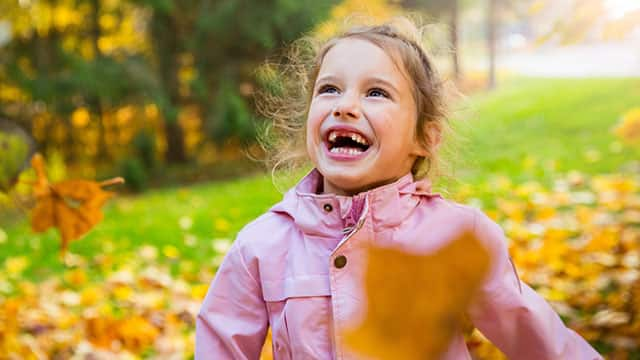Why Do Kids Lose Their Teeth?
First things first – why do the baby teeth fall out? Well, the baby teeth, also known as the primary teeth, need to fall out to make room for the permanent teeth (adult teeth) to come through as your child grows.
These adult teeth have been developing and growing in your child’s jaw, beneath their baby teeth, since before they were born. When a permanent tooth reaches a certain size, it starts putting pressure on the roots of the baby tooth above it, causing the roots to dissolve. As this happens, the baby tooth starts to loosen and eventually falls out. Shortly after, the new permanent tooth grows through in its place.
When Do Baby Teeth Fall Out?
The baby teeth usually start falling out in the same order they came through. According to the American Dental Association’s (ADA) tooth eruption guide, that typically goes as follows:
- 6-7 years old – upper and lower central incisors (front teeth).
- 7-8 years old – upper and lower lateral incisors (either side of the front teeth).
- 9-11 years old – upper and lower first molars (back teeth next to the canines).
- 9-12 years old – lower canines (fang teeth).
- 10-12 years old – upper canines and upper and lower second molars (the teeth right at the back).
The Mayo Clinic points out that every child is different; girls typically start to shed their baby teeth before boys, and some children may lose their first teeth up to a year later than their siblings or peers. So if your kiddo’s teeth don’t fall out in this order, or on this schedule, it’s usually nothing to worry about. However, if you have any concerns about your child’s baby teeth falling out (or not falling out), always check in with your dentist.
Will My Child Have Gaps in Their Smile?
Yes, your child’s smile will have gaps during the mixed dentition phase. This describes the period of time between approximately 6-12 years old, when your child has both baby teeth and permanent teeth. As baby teeth fall out and new teeth come through, your child will have temporary gaps, and teeth of different sizes. This is completely normal – adorable, even! – but you’ll want to keep a close eye on your child’s developing teeth to make sure they’re properly aligned as they come through. For example, you’ll want to look out for things like:
- An overbite, where the upper front teeth stick out over the lower teeth.
- An underbite, where the lower front teeth stick out over the upper teeth.
- A back bite, where the lower front teeth tip inwards.
- An open bite, where the upper and lower teeth don’t meet when the jaw is closed.
If you’re concerned about your child’s developing teeth, your dentist can check them, offer you advice, and refer you to an orthodontist if necessary.
What if My Child’s Baby Teeth Fall Out Early?
Those baby teeth may not be around forever, but they play an important role in your child’s future oral health. They act as placeholders for the permanent teeth, saving a space into which the new adult teeth can grow. If all goes to plan, those teeth usually arrive soon after the baby teeth fall out, moving into the space in the correct position.
But what if the baby teeth are lost before the permanent teeth are ready to erupt? When no permanent tooth moves into the space left by a baby tooth, pressure from chewing and biting can push the surrounding teeth into the gap instead. By the time the permanent tooth does arrive, there may no longer be enough space for it to properly erupt. It might come through crooked, it may be crowded with the other teeth, or it may not be able to come through at all.
Premature loss of baby teeth can happen due to injury or dental diseases like tooth decay, a very common condition in young children. However, while we can’t always prevent our little ones from accidents and injuries, tooth decay is entirely preventable. Read on to find out how to keep those baby teeth healthy and cavity-free.
How To Keep Baby Teeth Healthy
Like many things in life, the sooner you're able to start an oral hygiene routine with your child, the better. From birth, you can start by cleaning your baby’s gums every day with a clean gauze or washcloth. This gets your baby used to oral care, so you can seamlessly transition to toothbrushing and dental visits when the time comes.
From the moment the first tooth comes through, you can protect those tiny chompers by:
- Brushing your child’s teeth twice per day, for two minutes each time.
- Using an age-appropriate amount of fluoride toothpaste (that’s a smear for under-twos, and a pea-sized amount for kids two and older).
- Seeing their dentist twice per year for check-ups and professional cleanings.
- Introducing flossing or interdental cleaning as soon as your child has two teeth that touch.
If you're able to teach and establish a good oral care routine with your child, you'll be well ahead of the curve when it comes to preventing plaque, tooth decay and cavities.
What to Do When Your Child Has Loose Baby Teeth
The process of losing baby teeth is completely natural, so once you notice your child's baby teeth are loose and wiggly, let your child gently wiggle the tooth if they want to. When the tooth is ready to go, it should fall out easily and with little bleeding. If your child is desperate to lose the tooth and it just won't come out, the American Dental Association advises parents to fold a piece of clean tissue over the tooth and gently squeeze. If it’s ready to come out, the tooth should pop out right away.
However, if the tooth doesn't come out with a gentle squeeze, don't reach for the string and stay away from doorknobs. As we mentioned earlier, losing a baby tooth before it’s ready can affect the position of the permanent teeth and lead to crooked teeth and crowding.
Tips on Easing Your Child's Fears
As a parent, you may be excited that your child has arrived at the milestone of losing their first tooth, but for the child, it can sometimes be a scary experience. If your child is upset about a wiggly tooth or a gap where a tooth fell out, offer reassurance that nothing is wrong and that everyone loses their baby teeth. Remind your child that the tooth fairy loves baby teeth and gives out rewards for them. Additionally, if a tooth looks like it's about to come out, consider giving your child a small box and a tissue or a similar "tooth kit" to take to school to avoid losing the precious item.
What to Do When the Tooth Falls Out
Now that your child has started losing baby teeth, it’s time to reinforce the importance of good oral care:
- Encourage and even remind your child to brush their teeth twice a day.
- Show your child how to clean between their teeth with floss or another kid-friendly interdental cleaning device.
- Limit sugary or other unhealthy snacks.
- Schedule regular visits to the dentist’s office.
This is also a time to celebrate! Don’t forget to take pictures of your little one’s new smile. You can even make a scrapbook to commemorate the changes in your child’s smile over the years. But if you have any cause for concern about your child’s baby teeth falling out, remember that your dentist is always on hand and happy to help.
Oral Care Center articles are reviewed by an oral health medical professional. This information is for educational purposes only. This content is not intended to be a substitute for professional medical advice, diagnosis or treatment. Always seek the advice of your dentist, physician or other qualified healthcare provider.
ORAL HEALTH QUIZ
What's behind your smile?
Take our Oral Health assessment to get the most from your oral care routine
ORAL HEALTH QUIZ
What's behind your smile?
Take our Oral Health assessment to get the most from your oral care routine
Join Us
Get the best of your oral health routine and take it to the next level with expert advice, recommendations, products and solutions and special offers.
Join Us
Get the best of your oral health routine and take it to the next level with expert advice, recommendations, products and solutions and special offers.















